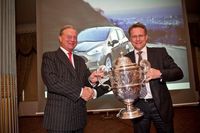Ford 1.0-Litre Ecoboost Engine Wins The Dewar Trophy 2012
BRENTWOOD, UNITED KINGDOM – Nov 2, 2012: Ford’s new 1.0-litre three-cylinder EcoBoost engine has notched up another accolade with the award of the The Dewar Trophy 2012. The trophy, for outstanding British technical achievement in the automotive industry, was presented to Graham Hoare, Head of the Ford Dunton Technical Centre, and members of the EcoBoost engineering team at the Royal Automobile Club this week.
Ford triumphed over 35 other companies and organisations to gain a unanimous verdict from the judging panel. The Ford team was recognised for setting themselves challenging targets and bringing together a significant number of advanced technologies to push the boundaries of engine design.
“Ford‘s engineers at Dunton have produced an outstanding downsized powertrain that delivers exceptional economy while achieving the high torque and relaxed driving characteristics normally associated with a diesel and the smooth, free-revving qualities of a petrol engine, that has won acclaim from everyone who has driven it,” said John Wood MBE, Chairman of the Dewar Technical Committee.
Steve Cropley, Dewar Technical Committee member and Editor-in-Chief of Autocar magazine added: “Ford’s 1.0-litre EcoBoost engine sets extraordinary new standards of efficiency, refinement and driver appeal — and brings them to the mass of British drivers who buy and drive affordable cars.”
The engine – small enough to fit on an A4 sheet of paper – was designed at Ford’s Technical Centre in Dunton, UK. The three-cylinder engine is available in the Ford B-MAX, the Ford Focus and the Ford C-MAX. In addition to the Dewar Trophy, Ford’s 1.0-litre EcoBoost was recently awarded the title of “International Engine of the Year.”
1.0-litre EcoBoost innovations:



